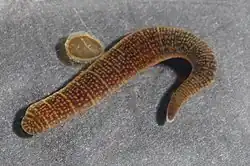Arhynchobdellida
| Proboscisless leeches | |
|---|---|

| |
| A giant Americobdella species from southern Chile. | |
| Scientific classification | |
| Kingdom: | Animalia |
| Phylum: | Annelida |
| Clade: | Pleistoannelida |
| Clade: | Sedentaria |
| Class: | Clitellata |
| Subclass: | Hirudinea |
| Infraclass: | Euhirudinea |
| Order: | Blanchard, 1894 |
| Suborders | |
|
Erpobdelliformes | |
| Synonyms | |
|
Arhynchobdellae Stuart, 1982 | |
Arhynchobdellida, the proboscisless leeches, are a monophyletic order of leeches. They are defined by the lack of the protrusible proboscis that defines their sister taxon, the Rhynchobdellida.[1][2][3] Arhynchobdellida is a diverse order, compromising both aquatic and terrestrial, besides sanguivorous and predatory, leeches.[3] The order is divided into two suborders, Erpobdelliformes and Hirudiniformes (sometimes also called the Pharyngobdelliformes and Gnathobdelliformes, respectively).[1]
Taxonomy
Historically, the Arhynchobdellida were split into two orders, the Gnathobdellida and the Pharyngobdellida.[4] The Gnathobdellida were jawed and carnivorous or parasitic while the Pharyngobdellida were jawless and carnivorous.[5][6] Current taxonomy accepts the order Arhynchobdellida and divides into two suborders. There are 215 species of Arhynchobdellid leech, in 47 genera and 13 families.[7] The placement of Americobdellidae is uncertain; it has rudimentary jaws and is terrestrial.

Erpobdelliformes
Erpobdelliformes are jawless predators of aquatic invertebrates of varying sizes, including insect larvae, mollusks, and other annelids.[8][9] Unlike other leeches, they do not penetrate the skin of hosts; and are not at all parasitic.[10][11] The pharynx is spirally twisted and very large to allow for large prey; it can constitute up to one third of the leech's body length.[1]
Hirudiniformes
Hirudiniformes are a diverse suborder defined by the presence of toothed jaws.[1][11]
Cladogram
| Hirudinea |
| ||||||||||||||||||||||||||||||||||||||||||
Source:[12]
References
- ^ a b c d Ax, Peter (2000), Ax, Peter (ed.), "Rhynchobdellida — Arhynchobdellida", Multicellular Animals: The Phylogenetic System of the Metazoa. Volume II, Berlin, Heidelberg: Springer, pp. 72–76, doi:10.1007/978-3-662-10396-8_18, ISBN 978-3-662-10396-8, retrieved 2022-12-31
- ^ Ecology, Environment and Conservation. EM International, Publishers of Quality International Journals. doi:10.53550/eec.
- ^ a b Uttam, Suneha, and Seema Langer. "Distribution and Identification key for species of freshwater leech genus Erpobdella Blainville, 1818 (Hirudinida: Arhynchobdellida: Erpobdelliformes: Erpobdellidae)."
- ^ "PAR volume 94 issue 1 Cover and Back matter". Parasitology. 94 (1): b1 – b3. Feb 1987. doi:10.1017/S0031182000053385. ISSN 1469-8161.
- ^ "Pharyngobdellida | Encyclopedia.com". www.encyclopedia.com. Retrieved 2023-01-01.
- ^ "Gnathobdellida | Encyclopedia.com". www.encyclopedia.com. Retrieved 2023-01-01.
- ^ "Proboscisless leeches - Encyclopedia of Life". www.eol.org. Retrieved 2023-01-01.
- ^ Kwak, Hee-Jin; Kim, Jung-Hyeuk; Kim, Joo-Young; Jeon, Donggu; Lee, Doo-Hyung; Yoo, Shinja; Kim, Jung; Eyun, Seong-il; Park, Soon Cheol; Cho, Sung-Jin (2021-05-25). "Behavioral variation according to feeding organ diversification in glossiphoniid leeches (Phylum: Annelida)". Scientific Reports. 11 (1): 10940. Bibcode:2021NatSR..1110940K. doi:10.1038/s41598-021-90421-1. ISSN 2045-2322. PMC 8149456. PMID 34035418. S2CID 235199192.
- ^ "Phylogeny and Revision of Erpobdelliformes (Annelida, Arhynchobdellida) from Mexico Based on Nuclear and Mithochondrial Gene Sequences". Docslib. Retrieved 2022-12-31.
- ^ Kutschera, U. "Description of a new leech species, Erpobdella wuttkei nov. sp.(Hirudinea: Erpobdellidae)."
- ^ a b Borda, Elizabeth; Siddall, Mark E (Jan 2004). "Arhynchobdellida (Annelida: Oligochaeta: Hirudinida): phylogenetic relationships and evolution". Molecular Phylogenetics and Evolution. 30 (1): 213–225. Bibcode:2004MolPE..30..213B. doi:10.1016/j.ympev.2003.09.002. ISSN 1055-7903. PMID 15022771.
- ^ Borda, Elizabeth; Sidall, Mark (2004-12-30). "Review of the evolution of life history strategies and phylogeny of the Hirudinida (Annelida: Oligochaeta)". Lauterbornia. 52: 7–15 – via ResearchGate.